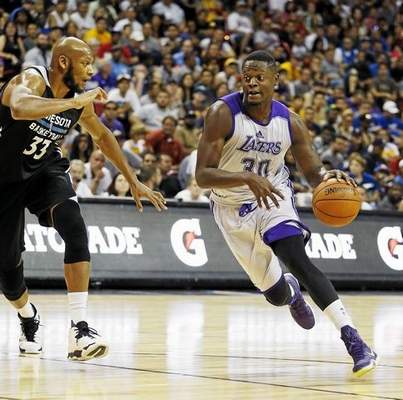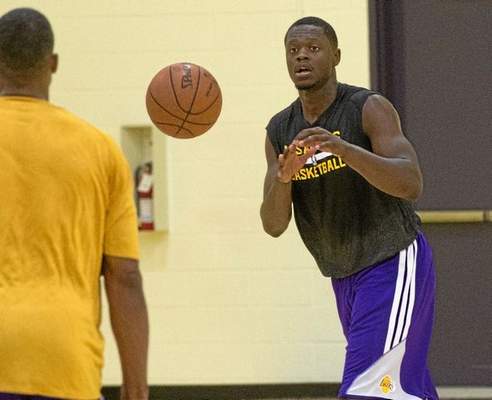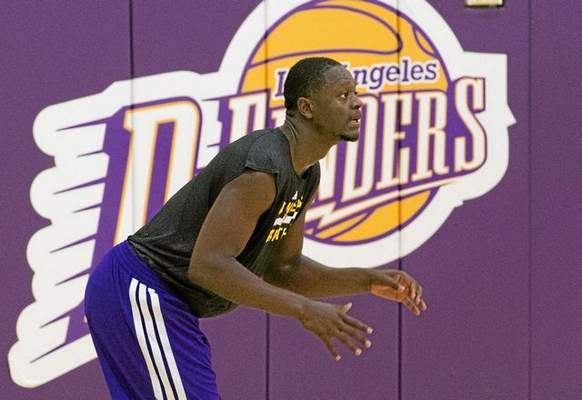
Lakers’ Julius Randle has comed to grips with last year’s injury. “It made me appreciate and love the game even more.” (AP Photo/John Locher)
Below is a Q&A with Lakers strength and conditioning coach Tim DiFrancesco, who detailed Julius Randle’s off-season workouts and dietary habits. I detailed Randle’s efforts in those areas as well as his year-long recovery in the print edition. But below is an expansive transcript of my interview with DiFrancesco earlier this summer at the Lakers’ practice facility in El Segundo.
What has gone into Julius’ improvement with his dieting?
DiFrancesco: “With Julius, he just recognized that in order to see the body composition changes, it was going to have to be a two-pronged approach. Nutrition with the food piece was going to have to be tightened up and taken more seriously. He was never terrible with it. But there were some subtle things to tighten up.
He watched the amounts of sugar and he was getting more leafy greens. The leafy greens were big. Bone health for him is better. I don’t have to explain why that was very important. The leafy greens provided the fiber and that made him more full when he eats so he doesn’t feel like he’s hungry right after eating something and always feel like he’s reaching for something else.
There were the different vitamins and minerals that helped with his bone building and fighting inflammation. That was huge. He took that stuff very seriously. He’s very good. Everybody has a little junk food here and there. But he’s really good about keeping it at a minimum. Once he really decided to do that, it’s helped a lot.”
What has that done for him?
DiFrancesco: “He was in a hard situation. After he was in two consecutive boots and not able to be very active, all of a sudden he got cleared toward doing some things. At any level he has ever been at, he has been physically more dominant than most players he played against. He started to feel, ‘I am already physically dominant, I have a nice body here. But if I get in the weight room and do some of the more heavy lifting work and moving weight around, the possibilities are endless here.’
He started to feel that in his workouts. The goal is not to make him look like a body builder. The goal for him is to take unusable fat mass and get rid of that and replace that with functional muscle mass. That’s what we tried to do, with trimming the body weight down so we can take off some pressure.
He’s a big boy. He wants to take pressure off the lower body because he had issues in his foot and leg. That’s going to be important. You can’t just lose fat, and then not put muscle on him. His game specifically is designed around giving hits and taking hits. He’s a bull out there. That’s how he plays and is going at a fast speed and is giving hits. He has to be able to take hits when he’s up there at the rim. Maybe one of the bigger things for him is to get his lower body under the right amount of resistance load.
Everybody thinks you lift weights for muscles. But for him, he already has a huge body and is very explosive. So he has to be able to absorb the impact and decelerate from those fast speeds with a lot of mass coming down. Those sort of support structures of the muscular skeletal system with the tendons, ligaments and bones. For him, that’s in my mind what was the ultimate foundation. Once he got into a routine, he works man. He’s a worker. He eats up workouts and looks at me like ‘What’s next?’ When other guys are 3/4 of the way through, they’re asking, ‘How much more?’ He’s finished and asks, ‘What’s next?’ He is an impressive worker.”

Lakers’ Julius Randle worked out with Metta World Peace throughout the summer. (Thomas R. Cordova/Daily Breeze)
How much is he weighing these days versus when he came in his rookie year?
DiFrancesco: “We had him at 265 pound range, potentially even slightly higher than that, plus or minus a few. At 14% body fat. We got him now toward closer to the 250-255 range at 9.5-10% body fat. (Note: This interview took place earlier this summer. In a recent interview with Randle, he said he currently weighs between 244-45 pounds at just under 10% body fat).
What’s the ideal weight/body fat percentage for Julius?
DiFrancesco: “I don’t really know. The kid is still very young. I’m very happy with where we’re at right now. But there’s still going to be progress. If this is where we sit, I’m very pleased with this. But there’s going to be even more progress. He’s going to be getting minutes in games where he’s also going to be burning calories.
I’m assuming he continues with his ferocious appetite for the weight room that he developed. He’s going to continue to lose some body fat and continue to gain some muscle. That’s what it all comes down to. He has shown that he is really willing and has an appetite for work. You can have the best plan in the world and all the best ideas to do stuff. But if the kid just doesn’t have it and is going through the motions and doing just enough to get by, you’ll never see significant changes. So with him, that’s what it is.”
What’s the breakdown between how much weight he lost in fat and any pounds he gained in muscle?
DiFrancesco: “He traded roughly speaking about 10 pounds of fat for 10 pounds of muscle. It’s plus or minus a little bit. We have the ability to roughly estimate those values. That’s very important. Those are not concrete. The only way you can know that is if you basically took an MRI of the individual or if you dissected the person. You wouldn’t know. These are all within reason. He lost about 15 to 20 pounds [in fat]. But there’s some variation within those numbers. He didn’t gain any fat.”

The Lakers’ Julius Randle said he’s more mentally and physically prepared for the NBA than he was last year. (Thomas R. Cordova-Daily Breeze/Press-Telegram)
What things did you expose him to that helped change his diet?
DiFrancesco: “We went to Whole Foods and tried to find some things he could put in the cupboard. One of the things we worked on heavily was how to make a delicious healthy salad. If you change some of the intensity of the nutrients where you’re eating junk food, that doesn’t have much substance to the calories. You eat it and suddenly feel hungry again.
There’s not a lot there besides refined carbohyrdrates, sugars, the bad fats and stuff like that. Then you change that for more intense nutrients, fiber and healthy fats and having it more around so you can get it more in him. Then you’re not as hungry all the time. You’re not in that situation where at the end of the day, you’re just ravenous and you think whatever is in the cupboard, you grab anything. A Snickers bar? Perfect. Give me one of those, whatever it might be.
He’s still a young kid. Anybody is going to have a craving for some junk food here and there. He knows that he can’t be perfect all the time. That’s part of making it sustainable, where you have to let yourself off the hook and enjoy some junk food here or there. But instead of just making that your first option every time, now it becomes a much better and selective process. Then it’s at the point where, ‘I’ve been very good for the last week and I don’t feel bad and I won’t ruin my progress by grabbing the fast food meal here or there or getting some sweet afterwards.'”
When was the Whole Foods visit?
DiFrancesco: “It was shortly after the season ended. We focused on that trip on the big salad. Sometimes when you go and say, ‘This is where you should get at the grocery store’ and there’s 1,000 things on the list, it’s overwhelming. I found that it’s a little bit easier to say to guys, ‘Let’s work on finding the 10 ingredients or six ingredients you need to make a good salad that you enjoy that hits all your nutritional needs.’
Even that is a lot to process if you’re not used to doing your own cooking and stuff like that. He took to it and we brought it back to his house and we made the salad and we had it. He said he really liked it. So he has that in his toolbox, the ability to walk into Whole Foods anytime he wants and gets the ingredients for the salad that he likes.
Then we’ll go back again. It’s still a work in progress. We still have more trips to go where next time we might figure out how to make a healthy cheeseburger and show him how to do that and make it on his own so that during those moments when it’s real easy to get that fast food, we have an alternative.”
Since Julius is considered a versatile forward who could play both the 3 and 4, what conversations do you have with the coaching staff in determining his workout regimen?
DiFrancesco: “I try to watch as much in game or in practice live action as I can and be able to assess that on my own. I also have a conversation with Mitch [Kupchak] and the coaching staff on how he needs to be a little bit lighter, but still strong enough to play the 4 if he needs to. The kid has so much he is able do.
But ultimately his style of play is revolved around getting the rebound, pushing himself and getting all the way to the rim himself. He’s a very good passer, too. He plays at a very violent pace and so we have that discussion with Mitch and the coaching staff with Byron or through Byron. Certainly that communication goes on there. But I take it upon myself to get as much live action assessment of what I see on how he’s doing things. Then I translate that into his workouts.
How was Julius when he first stepped on the court following his rehab?
DiFrancesco: “When he first started to get back into five-on-five play, he had a natural tendency to hold back the first couple of games. I noticed that clearly he was protecting that leg a little bit. It wasn’t blatant where he was doing too much too fast. But you could see moments where he wasn’t comfortable finishing a move that he normally would. He would stay away from it a little bit without making it look obvious.
His strength is not only in his diet with his calcium and bone building vitamins and minerals that come with those leafy greens and supplements. It’s the load-bearing and lower-body weight room work. It responds by growing stronger. Then as I saw him progress and saw him in five-on-five action, I saw him doing spin moves into the lane. He’s feeling comfortable. If he wasn’t feeling comfortable, he wouldn’t be moving on both legs or landing on the samae way and pushing off either leg the same way.”
How much did his lack of calcium, if any, contribute to his injury?
DiFrancesco: “That is not just with Julius. It’s with almost all NBA guys. Once that happened with Julius, we took a more aggressive approach. But we already were. We always have preached well before Julius got here that these are important nutrients to get. We try to assess and figure out based on the guy’s diet, bloodwork and things like that, how deficient is he in certain areas. I didn’t think it was anything where it was ‘Oh my gosh, he is super deficient in calcium or anything else.’
But he certainly wasn’t getting enough. That was present and evident and made clear. But you could say that about most kids in this locker room after going to high school and college and some of these things aren’t addressed. I don’t think it was anything where he was abnormally deficient in any area.
But like most guys his age that walk into our locker room, he had some deficiencies that we’ve now addressed. Even before the leg happened, we tried to address that. It’s just that sometimes it takes time to take those deficient levels and increase them high enough.”
RELATED:
Lakers’ Julius Randle no longer angry about last year’s injury
Julius Randle unafraid, unfazed vs. Metta World Peace
Five things to watch in Julius Randle’s 2015-16 season
Follow L.A. Daily News Lakers beat writer Mark Medina on Twitter and on Facebook. E-mail him at mark.medina@langnews.com
